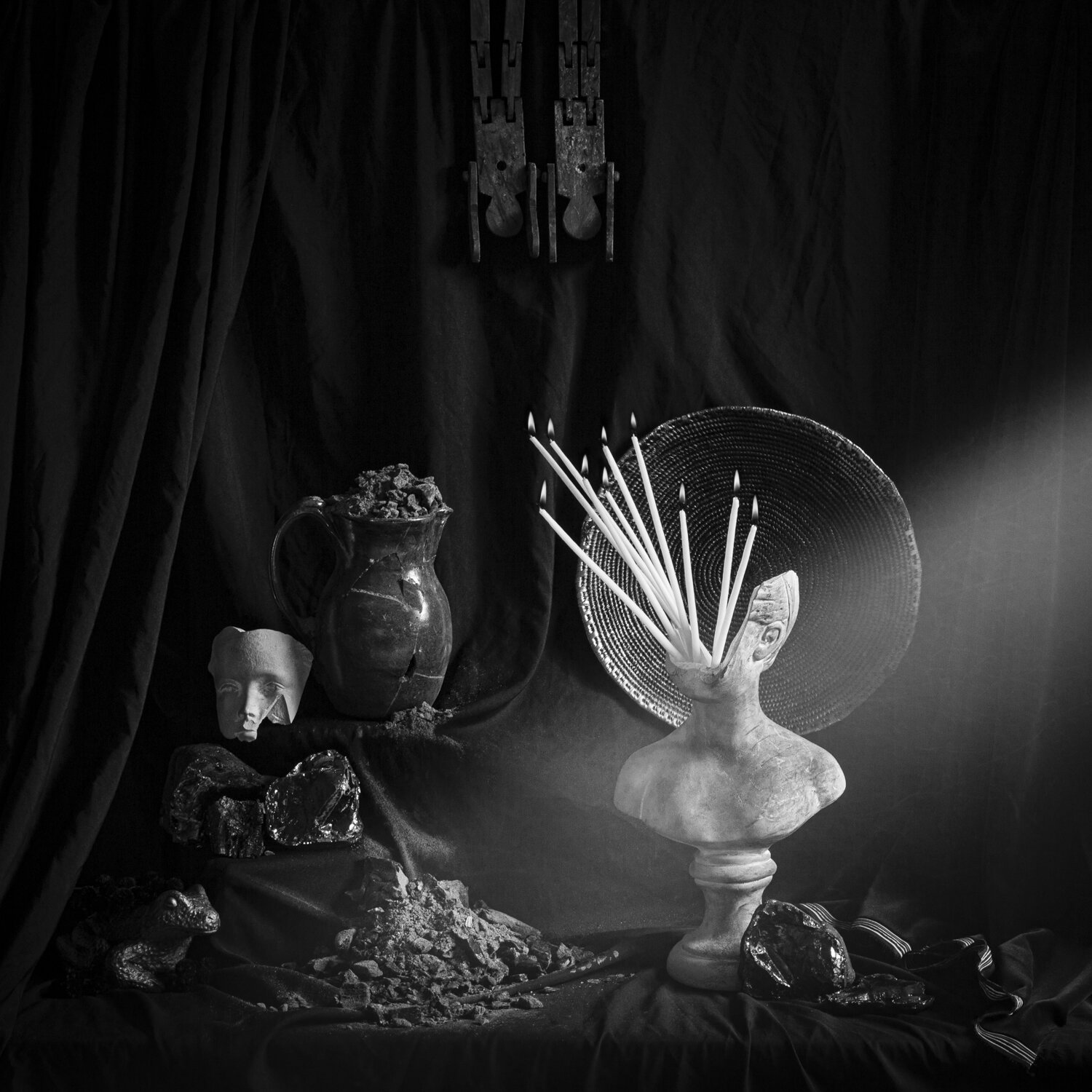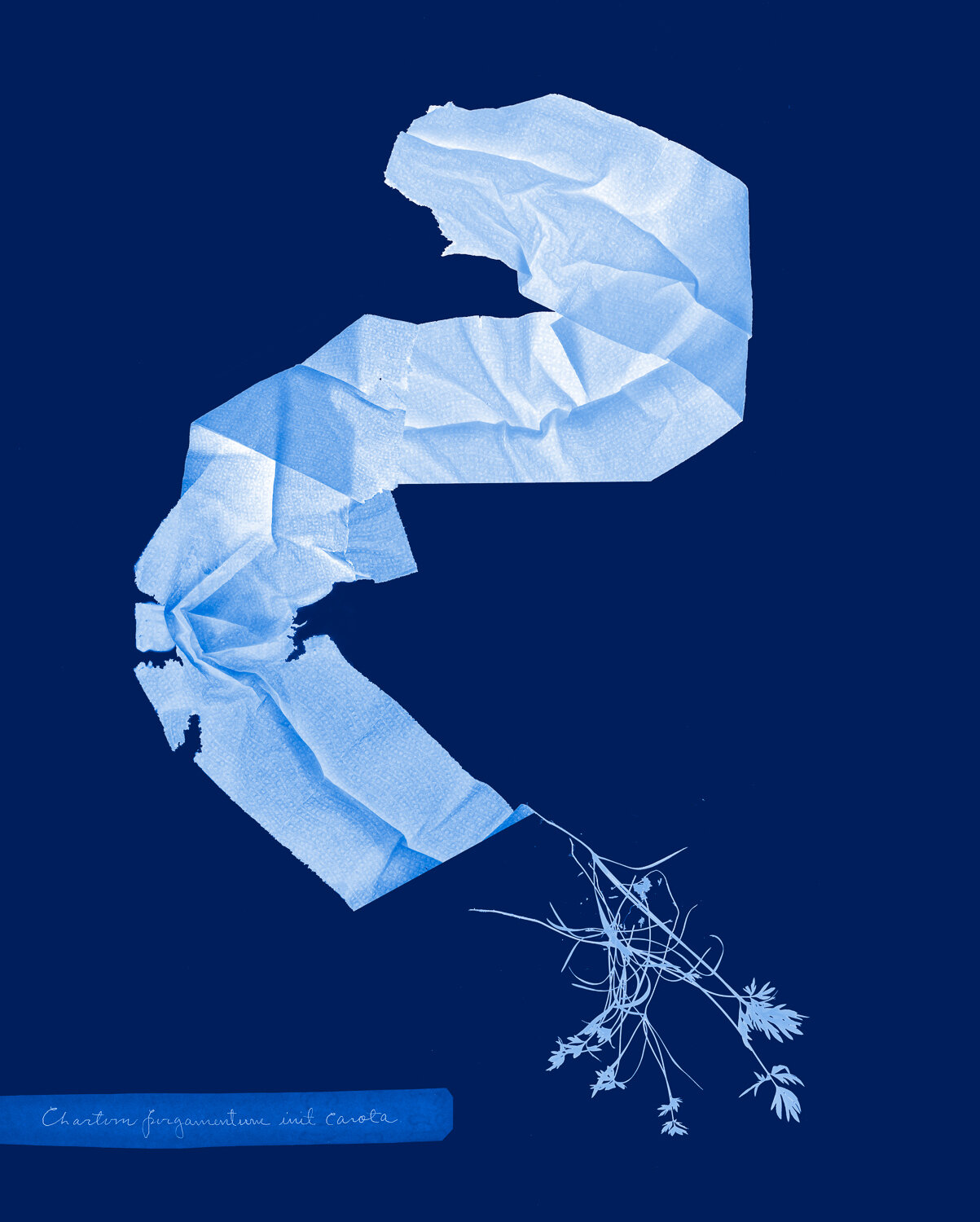ARTIST BREAKDOWN P.I: Photography is Dead...
Photography is Dead... Long Live Photography!
GROUP EXHIBITION
January 8 - February 20, 2021
Over the next few weeks, we’ll be highlighting works currently on display here at the gallery. Follow along here and on social media for some background on each maker and their process. The call for this show was centered around 2020: what were the artists’ works-in-progress? What was that one-off piece that felt right in the moment, but didn’t fit into a larger series? What was their current reality? What were their thoughts and feelings about the future?
Bridget Conn. Modes of Breathing, 2020. Silver Gelatin Photographic Chemigrams, Thread
24 x 20 inches, Framed. Edition 1 of 1. $1000, Framed. Inquire to Purchase
In a current world preoccupied with breath, Bridget Conn’s Modes of Breathing is more than topical. Read on to learn about the thought behind Bridget’s threaded piece:
“I’ve spent most of 2020 preoccupied with the idea of breathing. Breath has played a role in every major event that has defined what I have learned this year. It started with its role in our current pandemic, my ability to control it to soothe panic attacks, and my realization of my privilege as a white American to not have it taken from me by those who are meant to protect me. This piece marks the first time I used my breath alone as a resist for chemigrams. With so many who are disregarding the power of breath, or taking it for granted, I am compelled to use it not just as subject matter, but as a material that is solely what makes silver gelatin paper transform in its reaction to light.”
Adrienne Catanese. Hail of Fire (from the series Plagues of Egypt), 2020. Archival Pigment Print, 16 x 16 inches. Edition 1 of 10. $750, Framed. Inquire to Purchase
What projects were you working on in 2020? Adrienne Catanese shares the concept behind her striking pandemic-inspired still life from her series, Plagues of Egypt:
"Hail of Fire is one image from a 10 image series called Plagues of Egypt:
Created during the 2020 coronavirus pandemic, Plagues of Egypt reinterprets the biblical plagues described in Exodus through a series of still life tableaux. All arrangements were constructed and photographed in the confines of my small apartment during several months of pandemic lockdown.
Building props was the most labor-intensive aspect of this work. My only access to materials was through the grocery store, a local thrift shop, and plant life found in my backyard. Thrifted items such as statues or toys were often sanded, painted, broken and mended, before being used. My process for each image included: biblical research to form a concept; sourcing, alteration, and arrangement of objects; and finally digital photographic capture and post-processing. At all points in this process, I drew upon art history, symbolism and metaphor, and my own experience growing up in born-again Christian theology.
We now find ourselves in conversations on both the personal and national levels interrogating the existential meaning of disease, death, plagues, and pandemics. Our desire for certainty is seen in our seeking of divine explanations, often to the exclusion of scientific ones. But the philosophical problem of evil asserts itself: our collective cultural heritage is shaped by stories of disease as divine punishment, and prayer as access to salvation from that punishment. We feel a sense of futility and helplessness in the face of a power that at once proclaims “Let my people go” while also hardening Pharaoh's heart, that unleashes pestilence, darkness, and death of the firstborn as easily as one might arrange objects in a still life.”
Colleen Mullins. Chartum purgamentum init carota, 2020 / after Anna Atkins, Alaria esculenta, 1848–49. Archival Pigment Print, 10 x 8 inches. Edition of 10. $750, Framed. Inquire to Purchase
Photo process + toilet scarcity come together in Colleen Mullins’ cyanotype work, with a nod to the beloved Anna Atkins that is simultaneously precious, humorous, and bleak.
“This piece encapsulates the hope and dread of 2020 perfectly for me. The relationship of the new growth of carrots, thinned from my deck garden, and an undulating DNA-like strand of toilet paper. The sad hope of nature, and the hoarding of a commodity--that is just a byproduct of a greater commodity in the trees we decimate to produce this luxury of the western world, is presented in homage to the biological studies produced by the great Anna Atkins. The absurdist assault on nature, and the idea of the scientific specimen, is perhaps the picture's greatest triumph.
The commodification of the commonplace has become a running theme of the COVID-19 pandemic. Having made homebodies of us all, COVID-19 has created absurd rolling shortages, of flour, hair dye, and of course, toilet paper. This was the genesis of the ongoing work by the Rolls & Tubes Collective, of which thesis one of my works. In this work, each of the four artists has reinterpreted a known photograph in the arc of the history of photography, utilizing toilet paper as an element of the image.
My prior work has one thread throughout--to create work on known themes (Hurricane Katrina; Camping; Monument Removal) and examining anomalous margins of the prevailing story. I see this effort by Rolls & Tubes as very much in keeping with this thread.”
Aamina Palmer. Fenced In, 2020. Mesh Banner. 48 x 72 inches. $1000. Inquire to Purchase
Aamina Palmer's piece is a large and striking image, printed on mesh banner, which serves as a symbol of her own 2020 experience.
“As a small piece in my collection of photos, the image of a weathered fence, came to resemble how I felt about certain moments in 2020. Looking past the rust and gaps, I could see what was behind it, but in front of me.
When I feel fenced in, I’m grateful to see through it. Looking forward even day by day allowed me to continue making and looking for new things to see.
I’m sharing this image from my collection, because it is 2020 captured.”
Alina Patrick. Visiting Mom, 2020. Archival Pigment Print, 16 x 16 inches. $400, Unframed. Inquire to Purchase
While some of our featured artists looked inward or began new research to create their 2020 projects, some were simply acknowledging the intimate world in which they were living. Alina Patrick’s image shares a quiet (and distant) moment with her mother, who was diagnosed with COVID-19.
"I took this image in March of 2020 while my mother was sick with COVID and I would sit in our backyard and talk to her from across the driveway. It was a scary time and just as we were speaking one day, the shadow of the biggest tree from our backyard fell on her from the doorway. She seemed so small and tired and when the shadow fell on her and the house I realized how strongly she was the foundation of our family and I wasn’t sure what we would do without her. It’s this image of separation, love, and fear of loss that I keep coming back to as a description for this year."





